

Biological Membranes Seen by Quantum Mechanics: Permeant Ions in Human Red Blood Cell and Resting Axolemma Squid Axon Membranes pp. 337-352. Www.cft.edu.pl/~birula/publ/APPPwf.pdf. Oco.uoregon.edu/sites/oco.uoregon.edu/files/TTRL5_V1.pdf. Www.m-hikari.com/astp/astp2012/astp5-8-2012/chandrasekarASTP5-8-2012.pdf. Www.phas.ubc.ca/~mcmillan/rqpdfs/5_qm_in_one_dimension.pdf. 19. Quantum Mechanics I: The key experiments and wave-particle duality. Paper test strip detects cancer in minutes. In places with little medical infrastructure, mammograms and colonoscopies can be too costly to implement.
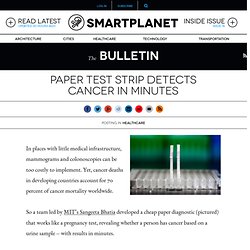
Yet, cancer deaths in developing countries account for 70 percent of cancer mortality worldwide. So a team led by MIT’s Sangeeta Bhatia developed a cheap paper diagnostic (pictured) that works like a pregnancy test, revealing whether a person has cancer based on a urine sample -- with results in minutes. The technology relies on nanoparticles that interact with tumor proteins, which trigger the release of biomarkers that can be detected in urine.
Specifically, we’re talking about tumor proteins called matrix metalloproteinases (MMPs), which help cancer cells escape by cutting through the proteins that hold the cancer cells in place. After these proteins are cut, the fragments accumulate in the kidneys and are then excreted in urine. To amplify signals from MMPs, the team coated nanoparticles with fragments of the proteins that are targeted by MMPs. Image: Bryce Vickmark. Blackbody Spectrum. Academo.org - Free, interactive, education. As an object heats up, it begins to emit light.

(If you're interested in the exact way in which this occurs, please head over to our demo of Planck's Law of Blackbody Radiation.) In very simple terms, a hotter object emits more high frequency radiation than a less hot one. For the sake of this explanation, a "hot" object will have a temperature of around 15,000 Kelvin, a "warm" object will be at approximately 6,500 Kelvin and a "cool" object will be around 1,500 Kelvin. Blue light has a higher frequency than red light, so it follows that hot objects will glow bluish, warm objects will glow white (made up from a combination of blue and red light), and cool objects will glow red. Using the term "cool" to describe something glowing red hot could be thought of as a slight misnomer, but it helps you to understand that compared to blue-hot objects, red-hot objects certainly are cool!
Credits Algorithm for generating RGB colours created by Tanner Helland. Java 1.1 Archive. Cooling Mechanisms for Human Body. This is an active graphic.
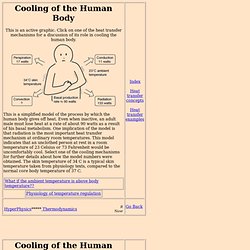
Click on one of the heat transfer mechanisms for a discussion of its role in cooling the human body. Even when inactive, an adult male must lose heat at a rate of about 90 watts as a result of his basal metabolism. This becomes a problem when the ambient temperature is above body temperature, because all three standard heat transfer mechanisms work against this heat loss by transferring heat into the body. Superbright and fast X-rays image single layer of proteins. (Phys.org) —In biology, a protein's shape is key to understanding how it causes disease or toxicity.
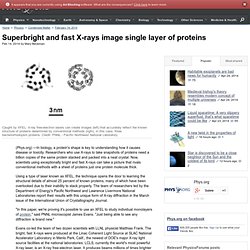
Researchers who use X-rays to take snapshots of proteins need a billion copies of the same protein stacked and packed into a neat crystal. Now, scientists using exceptionally bright and fast X-rays can take a picture that rivals conventional methods with a sheet of proteins just one protein molecule thick. Using a type of laser known as XFEL, the technique opens the door to learning the structural details of almost 25 percent of known proteins, many of which have been overlooked due to their inability to stack properly. The team of researchers led by the Department of Energy's Pacific Northwest and Lawrence Livermore National Laboratories report their results with this unique form of X-ray diffraction in the March issue of the International Union of Crystallography Journal. Photosynthesis protein developed long before oxygen became available.
Cyanobacteria living in oxygen-poor environments near underwater volcanoes and thermal vents reveal secrets of how their distant ancestors carried out respiration.

Surprisingly, they used a protein essential for photosynthesis long before oxygen became available. (Photo : Nat Tarbox) A protein essential for photosynthesis was in use by lifeforms long before oxygen was commonly available. This discovery could re-write much of what scientists believe about the biology of plants. Researchers from Virginia Tech examined chemical processes occurring in a variety of methane-forming bacteria called methanogens. When examining the life cycle of the bacteria, researchers found that the protein thioredoxin (Trx), which switches photosynthesis on in present-day cells, repaired proteins damaged by oxygen. Researchers believe the substance was used by ancient microbes, which produced methane as a waste product. Drawfacts #3: What is Blackbody radiation? Just how small is an atom? - Jonathan Bergmann.
Green light: Is it important for plant growth? Green light is considered the least efficient wavelength in the visible spectrum for photosynthesis, but it is still useful in photosynthesis and regulates plant architecture.
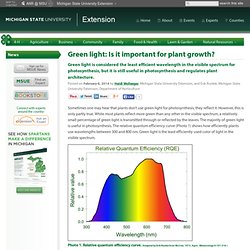
Posted on February 6, 2014 by Heidi Wollaeger, Michigan State University Extension, and Erik Runkle, Michigan State University Extension, Department of Horticulture Sometimes one may hear that plants don’t use green light for photosynthesis, they reflect it. However, this is only partly true. While most plants reflect more green than any other in the visible spectrum, a relatively small percentage of green light is transmitted through or reflected by the leaves. QM Virtual Laboratories. Quantum Mechanics Simulations We have created two programs that simulate experiments studying the behavior of photon pairs.
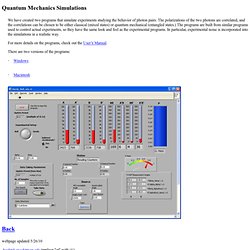
The polarizations of the two photons are correlated, and the correlations can be chosen to be either classical (mixed states) or quantum mechanical (entangled states.) The programs are built from similar programs used to control actual experiments, so they have the same look and feel as the experimental programs. In particular, experimental noise is incorporated into the simulations in a realistic way. For more details on the programs, check out the User’s Manual. There are two versions of the programs: · Windows.
Photoelectric Effect - Light, Quantum Mechanics, Photons. Dr Quantum - Double Slit Experiment. Dr Quantum - Double Slit Experiment. Modern Quantum Mechanics Experiments for Undergraduates. Textbook.
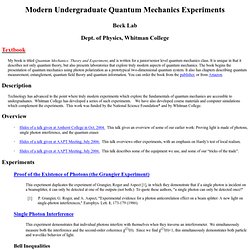
How to Build Your Own Quantum Entanglement Experiment, Part 1 (of 2) Quantum entanglement experiments are not something you can buy in the science kit aisle at Toys ’R Us.
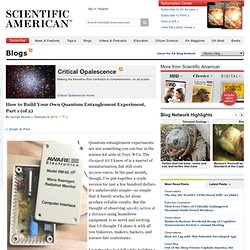
The cheapest kit I know of is a marvel of miniaturization, but still costs 20,000 euros. In the past month, though, I’ve put together a crude version for just a few hundred dollars. It’s unbelievably simple—so simple that it barely works, let alone produce reliable results. But the thought of observing spooky action at a distance using homebrew equipment is so novel and exciting that I’d thought I’d share it with all you tinkerers, makers, hackers, and science-fair contestants. I got the idea last fall while building a supersimple cloud chamber. Doing a literature survey, I found that the very first entanglement experiment, performed by Ernst Bleuler and H.L. Today, physics students at Caltech, the University of Edinburgh, and elsewhere routinely perform the Wu-Shaknov experiment. The parts I use are: Photon Quantum Mechanics. Photon Quantum Mechanics This is a project funded by the National Science Foundation to establish a set of undergraduate laboratories to study the fundamentals of quantum mechanics.

The experiments are laboratory exercises on topics of quantum mechanics that are otherwise theoretical, abstract or even unintuitive. Photon Quantum Mechanics.